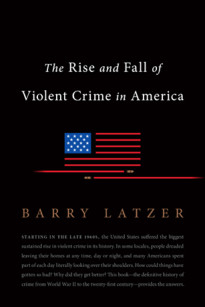Barry Latzer, criminal justice scholar and author of The Rise and Fall of Violent Crime in America, discusses the roots of violent crime in a fascinating interview with The Atlantic‘s David Frum. In their most provocative exchange, Latzer puts forward an explanation for violent crime that cuts against the conventional—and politically correct—wisdom: crime is not fueled by poverty or racism, argues Latzer, but by culture.
The relevant exchange is below:
Frum: That answer showcases the most provocative feature of your book: your belief that different cultural groups show different propensities for crime, enduring over time, and that these groups carry these propensities with them when they migrate from place to place. As I don’t have to tell you, this idea and its implications stir more controversy among criminologists than any other. Would you state your position as precisely as possible in this brief space?
Latzer: First of all, culture and race, in the biological or genetic sense, are very different. Were it not for the racism of the 18th and 19th centuries, we might not have had a marked cultural difference between blacks and whites in the U.S. But history cannot be altered, only studied and sometimes deplored.
Different groups of people, insofar as they consider themselves separate from others, share various cultural characteristics: dietary, religious, linguistic, artistic, etc. They also share common beliefs and values. There is nothing terribly controversial about this. If it is mistaken then the entire fields of sociology and anthropology are built on mistaken premises.
If cultural differences don’t explain this, then what does?
With respect to violent crime, scholars are most interested in a group’s preference for violence as a way of resolving interpersonal conflict. Some groups, traditionally rural, developed cultures of “honor”—strong sensitivities to personal insult. We see this among white and black southerners in the 19th century, and among southern Italian and Mexican immigrants to the U.S. in the early 20th century. These groups engaged in high levels of assaultive crimes in response to perceived slights, mainly victimizing their own kind. This honor culture explains the high rates of violent crime among African Americans who, living amidst southern whites for over a century, incorporated those values. When blacks migrated north in the 20th century, they transported these rates of violence. Elijah Anderson’s book, The Code of the Streets, describes the phenomenon, and Thomas Sowell, in Black Liberals and White Rednecks, helps explain it.
In the case of blacks, the big change in terms of violence was the high robbery rates and the concomitantly high white victimization rates of the post-60s era (robbery being a crime against strangers). These were products of the massive postwar spike in black migration to northern cities (800,000 in the 1960s; 1.8 million in the ‘70s); the black baby boom coming of age for violence (late adolescence, early manhood); a youth crime contagion, in which crime became cool and young males copied one another and began mugging with impunity; and the opportunities for victimization presented by whites who moved about northern cities with lots of cash and valuables.
Theories of crime that point to poverty and racism have the advantage of explaining why low-income groups predominate when it comes to violent crime. What they really explain, though, is why more affluent groups refrain from such crime. And the answer is that middle-class people (regardless of race) stand to lose a great deal from such behavior. Wisely, more affluent people go to law and seek other nonviolent methods to resolve interpersonal conflicts. Poor people, and especially young, male poor people, do not. Their perceived stake in the established order is tenuous.
The cultural explanation for violence is superior to explanations that rest of poverty or racism, however, because it can account for the differentials in the violent-crime rates of groups with comparable adversities. My favorite illustration of this is the Haitian situation in 1980s Miami. Here was a group of black people coming to the U.S. illegally in makeshift boats. They had a brutal history of slavery, and were illiterate in English, impoverished, and unwelcome. Yet their violent-crime rates were much lower than those of African Americans living in the same city in the same time period. If cultural differences don’t explain this, then what does?
Read the full interview here. And learn more in Barry Latzer’s full investigation of crime in The Rise and Fall of Violent Crime in America.
